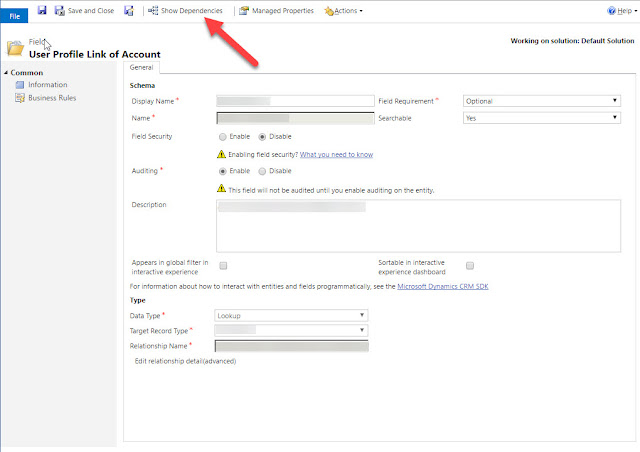by Gustaf Westerlund | Mar 18, 2017
Wrote an article a few days ago on the BPF new architecture and effects that it might have.
I spoke with Roger Gilchrist, a Principal Program Manager with the Product team during the eXtreme365 conference and he mentioned that using the “Process Stage” fields are actually not supported if you read the SDK very closely. This document is a very long document and it is not very clear in the UI and there is no other very obvious way of solving triggering on stage changes than the triggering on Process Stage changes, with which he did agree.
The important lesson from that, I think is that not everything you see in the UI is actually supported for use.
Gustaf Westerlund
MVP, Founder and CTO at CRM-konsulterna AB
www.crmkonsulterna.se

by Gustaf Westerlund | Mar 6, 2017
Seems like that Dynamics 365/CRM doesn’t catch all dependencies for managed solutions. This is how you can find and remove one of the tricky ones I got when uninstalling a managed solution which was:
Unhandled Exception: System.ServiceModel.FaultException`1[[Microsoft.Xrm.Sdk.OrganizationServiceFault, Microsoft.Xrm.Sdk, Version=8.0.0.0, Culture=neutral, PublicKeyToken=31bf3856ad364e35]]: During Solution Uninstall of Solution Id [solution-guid], cannot find any instances of the component with Component Id c97cd9d7-a0fa-4ed5-b360-3c2ad998a620 and Component Type 2.Detail:
<OrganizationServiceFault xmlns:i=”http://www.w3.org/2001/XMLSchema-instance” xmlns=”http://schemas.microsoft.com/xrm/2011/Contracts”>
<ErrorCode>-2147220970</ErrorCode>
<ErrorDetails xmlns:d2p1=”http://schemas.datacontract.org/2004/07/System.Collections.Generic” />
<Message>During Solution Uninstall of Solution Id [solution-guid], cannot find any instances of the component with Component Id c97cd9d7-a0fa-4ed5-b360-3c2ad998a620 and Component Type 2.</Message>
<Timestamp>2017-03-06T13:06:54.6280227Z</Timestamp>
<ExceptionSource i:nil=”true” />
<InnerFault i:nil=”true” />
<OriginalException i:nil=”true” />
<TraceText i:nil=”true” />
</OrganizationServiceFault>
After some thinking I figured that this was probably a reference to an attribute (Component type = 2) with the Guid = c97cd9d7-a0fa-4ed5-b360-3c2ad998a620 so I opened another attribute and then cut-n-pasted the url. And it seemed that you didn’t have to worry about the entity guid:
https://<onlineorgname>.<globalcrmcenter>.dynamics.com/tools/systemcustomization/attributes/manageAttribute.aspx?appSolutionId=%7bFD140AAF-4DF4-11DD-BD17-0019B9312238%7d&attributeId=%7bc97cd9d7-a0fa-4ed5-b360-3c2ad998a620%7d&entityId=%7b70816501-edb9-4740-a16c-6a5efbc05d84%7d
Change <onlineorgname> to your org, and <globalcrmcenter> to the crm-subdomain you are using, which for EMEA is crm4.
You will then see the field editor, and can then show the dependencies of the field and remove all of them manually to make sure they are not bothering the Solution uninstall. After that “publish all” and retry removing the solution.
Gustaf Westerlund
MVP, Founder and CTO at CRM-konsulterna AB
www.crmkonsulterna.se


Recent Comments